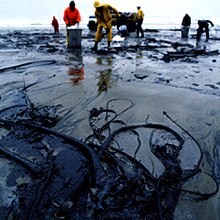
can we do when oil spill pollution arises?
step
an oil spill situation is observed, the first course of action is to call one of the nominated
response agencies. These are the national oil spill detection and respond
agency (NOSDRA, the police, the coast guard the fire department or the office
of disaster preparedness and national emergency management agency (NEMA).
If
unable to get through then call in one of the local radio stations and request
that a public disaster in the island, including oil spills information is
available from their revised catalogue or disasters.
waiting for a trained response team!!!
you are in an area that is crowded and people are gathering quickly to keep
persons away from the spill particularly children, who are keen to exercise
their natural sense of curiosity. A few simple rules should be observed NO
SMOKING, NO NAKED LIGHT, and DIVERT TRAFFIC (cars should not drive through,
boat should getting engines and net soiled). If the spill is on land and is
moving toward water-way such as a river, stream material such as rocks, stones,
dirt sand, leaves or trash. Banana trash has been shown to be a particularly
good absorbent.
Read this: What you need to know about oil spill pollution
measures
person upwind as fumes is given off by volatile components of the oil can have
serious effects. If the spill is in the sea or river avoid swimming and do not
catch or eat any fish or shellfish until the authorities have examined the
area. Do not collect water for drinking.
spills occurrences
ogoni, between 1993 and mid-2007, there have been a recorded 35 incidences of
oil spills. This is aside from the unnoticed slicks and unreported cases of
spills.
major causes of the spill incidences in ogoni include pipelines and flow lines
leakage/blowouts, blowouts from well-head due to poor maintenance and damage
and spills from flow stations
has been stated earlier, oil spills involved the release of dangerous
hydrocarbons such as benzene and polynuclear aromatic hydrocarbons into the
soil and water sources. These spillages affect vast stretches of land waterways
thus polluting not only crops but also marine life and the sources of water for
domestic uses. Mangrove sponges re-release it every rainly season.
other cases, the oil prevents the lenticels of the mangrove to absorb oxygen
hence oxygen starvation results. The mangrove withers and dies in large numbers
due to spill.
the spill occurs, it spreads on to farmlands and waterbodies. The toxic crude
seeps into the grounds and is taken up by the roots of plants. Recent studies
have shown that oil spills lower soil fertility and cause poor growth of
plants.
flaring
production involved the burning of hydrocarbon gases. The flaring-off natural
or associated gas is done as a by-product of the drilling of crude oil from
reservoirs in which oil and oil gas are mixed. One hundred percent of the gases
were flared, resulting in pollution of the environment. This made places like
ogoni area one of the most polluted areas in the world.
flares involve the release of dangerous hydrocarbon mostly methane and others
which include sulphuros oxide and the oxides of nitrogen into the atmosphere.
result of this unchecked emission of gases is the release of 35 million tons of
carbon dioxide and 12 million tons of methane which means that the Nigerian
oilfields contribute more to global warming than the world put together.
problem associated with gas flaring is light pollution. Light pollution
subjects the living organism around the vicinity of the 24-hour daylight. This affects
diurnality and night-time patterns in animals. The flares drive away games, it
affects the reproduction of fish as well as sending to deep sea areas.
and waste discharges.
source of oil related pollution is the discharge of effluents into the
surrounding environment, sometimes into the water, by the oil companies.
instance, during exploration or seismic surveys by oil companies, drill
cuttings, drilling mud and fluid are used
for stimulating production.
activities. The major constituent of drill cuttings such as baryotes and bentonitic
clays when dumped on the ground prevent local plant growth until natural
processes develop new topsoil. In the water, these materials are dispersed and
sink and may kill local bottom living plant and animals by burying them.
addition to the pollutant introduced into the environment from exploration and
exploitation, refinery wastes also have characteristic which constitute
potential land, water and air pollutant. The disposal of wastes into the sea
from oil facilitates has direct effect on fish stocks.
As we already know, oil oil spill pollution according to wikipedia is the release of a liquid petroleum hydrocarbon into the environment, especially marine areas, due to human activity, and is a form of pollution. Offshore oil spill prevention and response is the study and practice of reducing the number of offshore incidents that release oil or hazardous substances into the environment and limiting the amount released during those incidents.
Important aspects of prevention include technological assessment of equipment and procedures, and protocols for training, inspection, and contingency plans for the avoidance, control, and shutdown of offshore operations.




